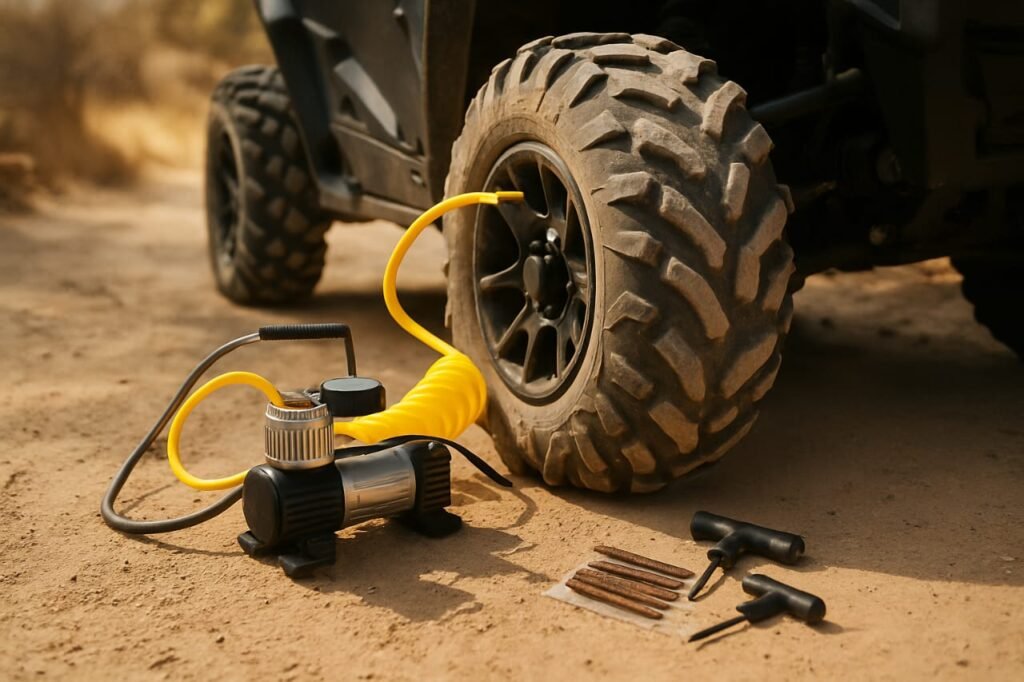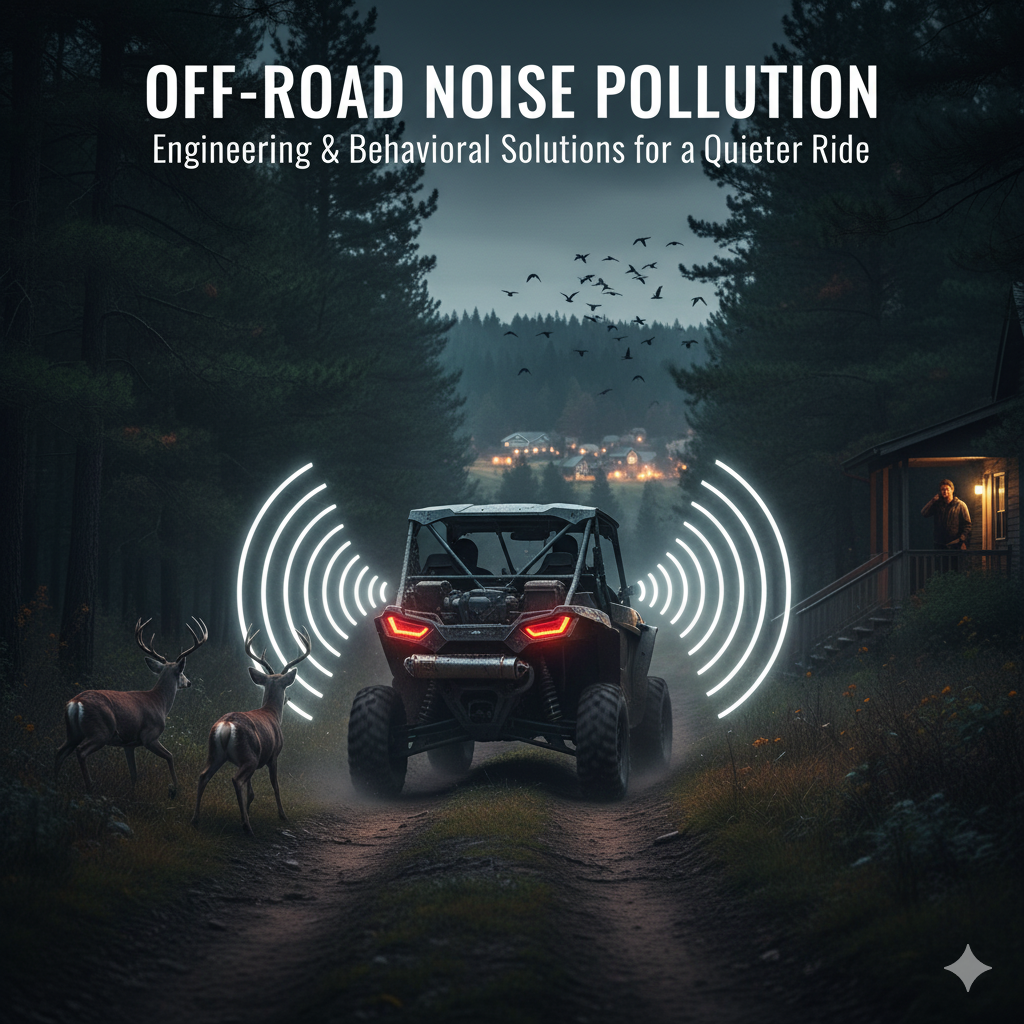There’s a certain freedom that comes with exploring remote trails in your UTV, far from the paved roads and crowded spaces.
But with that freedom comes the responsibility of being prepared for the unexpected.
One of the most common, and frustrating, setbacks you can encounter on the trail is a flat tire.
A puncture can quickly turn an epic adventure into a long, arduous walk back to civilization if you’re not equipped to handle it.
I’ve been there, staring at a deflated tire miles from anywhere, and let me tell you, it’s not a fun experience.
That’s why a compact air compressor is, in my opinion, one of the most crucial tools any UTV owner can carry.
While a tire plug kit can fix the hole, it’s useless without a way to reinflate your tire.
This is where a reliable, portable air compressor becomes your best friend. It’s not just about convenience;
it’s about self-sufficiency and ensuring your safety when you’re deep in the backcountry.
In this comprehensive guide, we’ll dive into everything you need to know about compact air compressors for UTV trail repairs.
We’ll cover what makes a good trail compressor, key features to look for, how to use one effectively, and even some top recommendations to help you choose the right one for your off-road adventures.
Don’t let a flat tire leave you stranded – let’s get you equipped to handle anything the trail throws your way!
What Makes a Good Trail Compressor? Power, Portability, and Durability
Not all air compressors are created equal, especially when it comes to the demands of off-road use.
A good trail compressor needs to be a trifecta of power, portability, and durability. Here’s what sets a reliable UTV trail compressor apart:
- Power (PSI and CFM):
- PSI (Pounds per Square Inch): This indicates the maximum pressure the compressor can achieve. While UTV tires typically run at lower PSIs (around 8-20 PSI), you need a compressor that can easily exceed this to seat beads or handle larger tires. Look for compressors capable of at least 100-150 PSI.
- CFM (Cubic Feet per Minute): This is arguably more important for rapid inflation. CFM measures the volume of air the compressor can move. A higher CFM means faster inflation times, which is crucial when you’re trying to get back on the trail quickly. For UTV tires, aim for a compressor with a CFM of 1.5 or higher at 0 PSI.
- Portability and Size: Space is often at a premium in UTVs. A good trail compressor should be compact and lightweight, making it easy to store in a cargo box, under a seat, or in a tool bag. Look for models with integrated handles or carrying cases for easy transport.
- Power Source: Most compact UTV compressors are 12V DC powered, meaning they plug directly into your UTV’s cigarette lighter outlet or connect directly to the battery terminals. Direct battery connection is often preferred for higher-draw compressors to avoid overloading the accessory outlet.
- Duty Cycle: This refers to how long the compressor can run continuously before needing to cool down. For trail repairs, you’ll want a compressor with a decent duty cycle (e.g., 30-50% at 100 PSI) to ensure it can inflate your tire without overheating. Some heavy-duty compressors offer a 100% duty cycle, meaning they can run continuously.
- Durability and Construction: The off-road environment is harsh. Your compressor needs to be built to withstand dust, dirt, moisture, and vibrations. Look for robust construction, metal components where possible, and sealed housings to protect internal workings. Many good trail compressors come with protective carrying cases.
Built-in Features:
-
- Pressure Gauge: An accurate, easy-to-read pressure gauge is essential for precise inflation.
- Long Air Hose: A long hose (15-25 feet) allows you to reach all four tires without having to move the compressor.
- Quick-Connect Fittings: These make attaching and detaching the hose to the compressor and tire valve quick and easy.
- LED Work Light: Useful for nighttime repairs.
- Automatic Shut-off: Some advanced models can be set to a desired PSI and will automatically shut off when that pressure is reached.
Choosing a compressor that balances these factors will ensure you have a reliable tool that can handle the demands of trailside tire repairs.
Don’t just grab the cheapest option; invest in a quality unit that won’t let you down when you need it most.

How to Use Your Compact Air Compressor for Trail Repairs: A Step-by-Step Guide
Having the right tools is only half the battle; knowing how to use them effectively is the other.
Using your compact air compressor for a trailside tire repair is a straightforward process, but following these steps will ensure you do it safely and efficiently:
1. Safety First:
Before doing anything, ensure your UTV is on stable, level ground. Engage the parking brake and turn off the engine.
If possible, place chocks or rocks around the tires that are not being worked on to prevent any accidental movement.
2. Locate the Puncture (if applicable):
If you’re dealing with a flat, you’ll need to find the source of the leak.
Visually inspect the tire for nails, screws, or other foreign objects.
If you can’t see anything, you can spray a mixture of soap and water on the tire’s surface; bubbles will indicate the leak.
Once found, mark it.
3. Prepare for Repair (if applicable):
If you have a puncture, you’ll need to plug it before inflating.
Follow the instructions for your tire plug kit.
This typically involves removing the foreign object, reaming the hole, and inserting a rubber plug.
4. Connect the Compressor:
-
- Power Connection: Plug your 12V compressor into your UTV’s accessory outlet or connect its alligator clips directly to your UTV’s battery terminals (red to positive, black to negative). Ensure a secure connection.
- Air Hose Connection: Attach the air hose to the compressor’s outlet. Then, firmly screw or clip the other end of the air hose onto the tire’s valve stem. Make sure it’s a tight seal to prevent air leakage.
5. Inflate the Tire:
-
- Start the Compressor: Turn on your air compressor. You’ll hear it begin to run.
- Monitor Pressure: Watch the pressure gauge on the compressor or an external tire pressure gauge. Inflate the tire to the recommended PSI for your UTV and the terrain you’re on. Remember, optimal PSI can vary significantly depending on whether you’re on hard-packed trails, sand, or rocks. (Refer to your UTV manual or a UTV tire pressure guide for specific recommendations).
- Avoid Over-inflation: Do not over-inflate the tire. This can be dangerous and can damage the tire or wheel.
6. Disconnect and Store:
Once the desired pressure is reached, turn off the compressor and disconnect the air hose from the valve stem.
Securely store your compressor and all its accessories back in their carrying case, ensuring they are clean and ready for your next adventure.
7. Re-check Pressure:
After driving a short distance (5-10 minutes), re-check the tire pressure.
Sometimes, the initial inflation might not be perfectly accurate, or the plug might settle. Adjust as necessary.
Practicing these steps at home can build your confidence, so you’re ready when a real trailside emergency arises.
A little preparation goes a long way in keeping your UTV adventures smooth and uninterrupted.
Conclusion: Your Essential Trail Companion
A compact air compressor is more than just a convenience; it’s an essential piece of gear for any UTV owner who ventures off the beaten path.
It provides the peace of mind that comes with knowing you can handle common tire issues independently, keeping your adventures on track and minimizing downtime.
From quickly airing up after a tire plug to adjusting pressures for varying terrains, a reliable portable compressor is an invaluable tool that empowers you to explore with confidence.
Don’t wait until you’re miles from civilization with a flat tire to realize you need one.
Invest in a quality compact air compressor, learn how to use it, and make it a permanent fixture in your UTV’s trail kit.
It’s a small investment that can save you a lot of hassle, frustration, and potentially a long walk.
So, gear up, hit the trails, and enjoy the freedom that comes with being prepared for anything!
What’s your go-to compact air compressor for your UTV?
Share your experiences and recommendations in the comments below!
References
[1] DrivingLine. Correct UTV Tire Pressure: Air Up, or Air Down?
[2] Valor Offroad. Tire Pressure on Your UTV.
[3] Perfex Industries. ATV Tire Pressure Guide: Find the Perfect PSI for Any Terrain!
[4] UTV Source. What Air Pressure Should You Run in Your UTV Tires? A Guide for Every Terrain.









